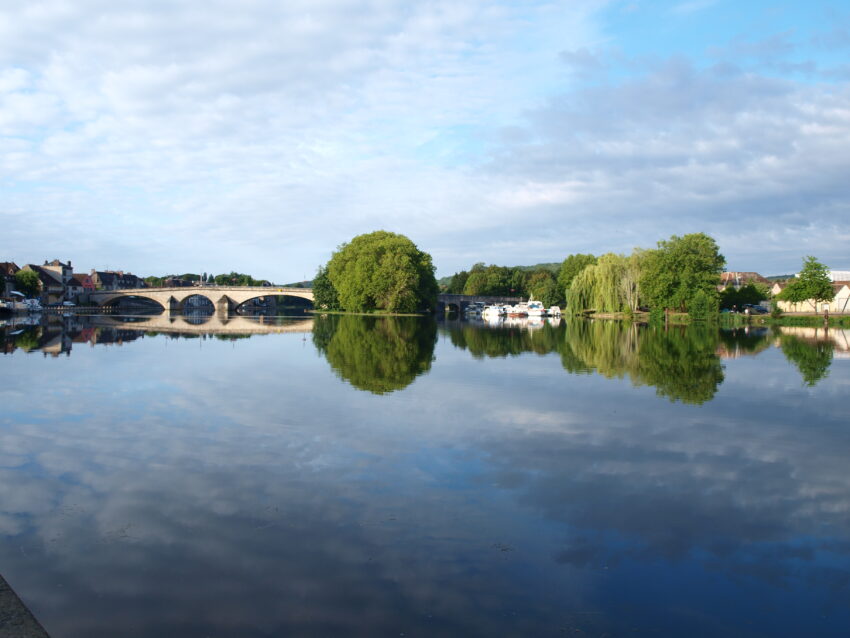Just after confinement lifted in France back in May of 2020, my husband and I began looking for things to do in the region(s) close to Troyes. Being the nerd that I am, and never having had the opportunity to visit, I suggested we go to Sens because I wanted to see the cathedral. After doing some research on the Sens & Senonais Tourism Office website, I soon discovered the ever-so-charming Villeneuve-sur-Yonne. Our day trip was set!
Our visit being just after the end of confinement, all museums and interior attractions were closed to the public.
Villeneuve-sur-Yonne
Middle Ages
In order to protect the limits of the kingdom of France from the County of Champagne, King Louis VII le Jeune (1137-1180) purchased the territory now known as Villeneuve-sur-Yonne in 1163. He named it “Villeneuve-le-Roy” (meaning “the king’s new city,” essentially). Conceived as a royal outpost, Villeneuve-le-Roy soon found itself protected by a thick two-meter-long, ten-meter-high wall embellished with five fortified gates.
Amongst the first structures to be built within the city were the Saint Nicholas Bridge (completed 1186) as well as the Church of Notre Dame de l’Assomption. Due to the creation of this bridge, the left bank of the town, known as “Villefolle” (“crazy town”), underwent major economic development. Not only was the bridge an important vector of commercial exchanges within the town, it became a crucial element for exchanges between the town and the surrounding territories.
Succumbing to economic difficulties created by the Hundred Years War and the fire of 1594 (during the Wars of Religion), Villeneuve lost its strategic importance from the 14th to the 16th centuries.
However, the town went through a rebirth in the 17th century.
The 17th & 18th Centuries
The return of traditional activities such as vineyards, tanneries and river trade during the 17th century contributed to this rebirth. In 1792, the town took its current name of Villeneuve-sur-Yonne during the French Revolution.
Monuments of Villeneuve-sur-Yonne
La Porte de Sens

The Porte de Sens is a gorgeous entryway constructed under the orders of King Philippe August. Dating to the 11th century, the northern façade has undergone very little modification. At the time of its creation, and as is still the case, the entry did not have any drawbridges. Instead, entry depended upon a portcullis, doors, and the watchful eye of archers. From the interior, one can see the staircases allowing access to the upper level of the gate and the city walls. Unfortunately, the 16th century saw the disappearance of the portcullis as well as its lifting system.
Le Pont (Saint Nicholas Bridge)

As previously mentioned, the Saint Nicholas Bridge is the first monument attesting to the new royal town. Texts mention its existence as early as 1186. Until the 14th century, it acted as a vector of commercial exchanges between the rich Gâtinais, the countries of the Loire and the fairs of Champagne. Such fairs, held in Troyes, Provins, Chalons and Reims, were the crossroads of all continental trade met in this period.
Of the 16 original arches in the bridge’s construction, only 7 remain. With the development of river trade, mainly to supply Paris, wider arches were necessary. Therefore, between 1733 and 1735, the engineer Boffrand enlarged the central arch. About a century later, in 1851 and 1861, more arches were rebuilt and widened. The bridge rests on the only island having survived the 19th century: the Île d’Amour (Island of Love). This island bears the remains of an element of the city’s advanced defense, the Barbe tower, used as a tollgate at the time.
Tour Bonneville (Bonneville Tower)
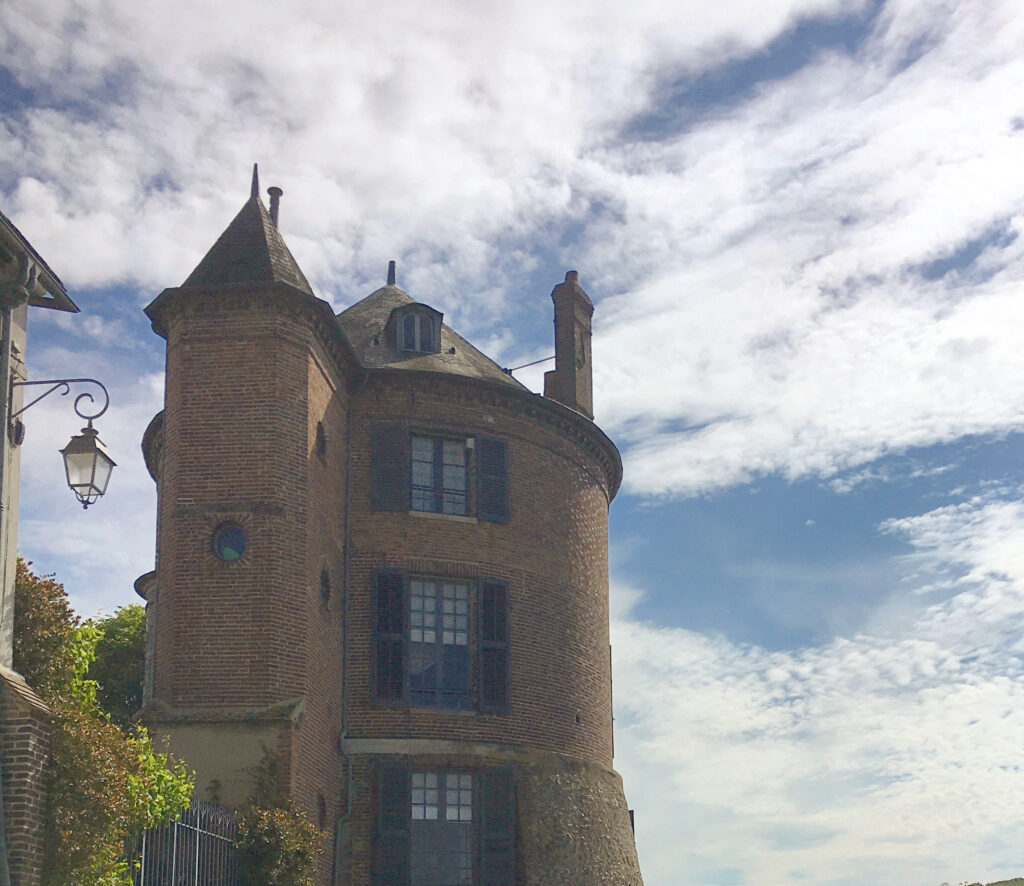
One of the six towers still present on the enclosure of the ramparts, the Bonneville tower is genuinely one of my favorite pieces of architecture that I saw at Villeneuve. The tower that is visible today is not how it would have originally looked. As visible in the photograph, the tower is divided by its original stone foundation and a red brick re-design dating to the 19th century. The stone foundation still bears the marks of the boat traction ropes. Today, the tower is a bed and breakfast.
La Porte de Joigny & the Historical Museum

Mirroring the Porte de Sens is the southern gate of the old medieval fortress, the Porte de Joigny. Another vestige of the fortifications built under the orders of King Philippe Auguste; it underwent profound modifications during the Renaissance.
Alterations took the form of mullioned windows on the façade while a high slate roof topped the ensemble. Much like the Porte de Sens, the entry depended upon a double portcullis which disappeared in the 16th century.
During the 18th century and up until 1837, this gate housed the town hall as well as a jail cell. Later, the second floor became the lodging of the night guard while the first floor was a rehearsal room for musical associations. Now, the entirety is a museum.
Due to the pandemic, we were unable to visit the museum, although it does seem really informative! The museum houses a collection exploring the history of the city and its fortifications. It is also home to a collection of Gendarmerie uniforms, from the Revolution to the present day.
For more information about the museum and visiting times, please consult their website.
Eglise Notre-Dame de l’Assomption
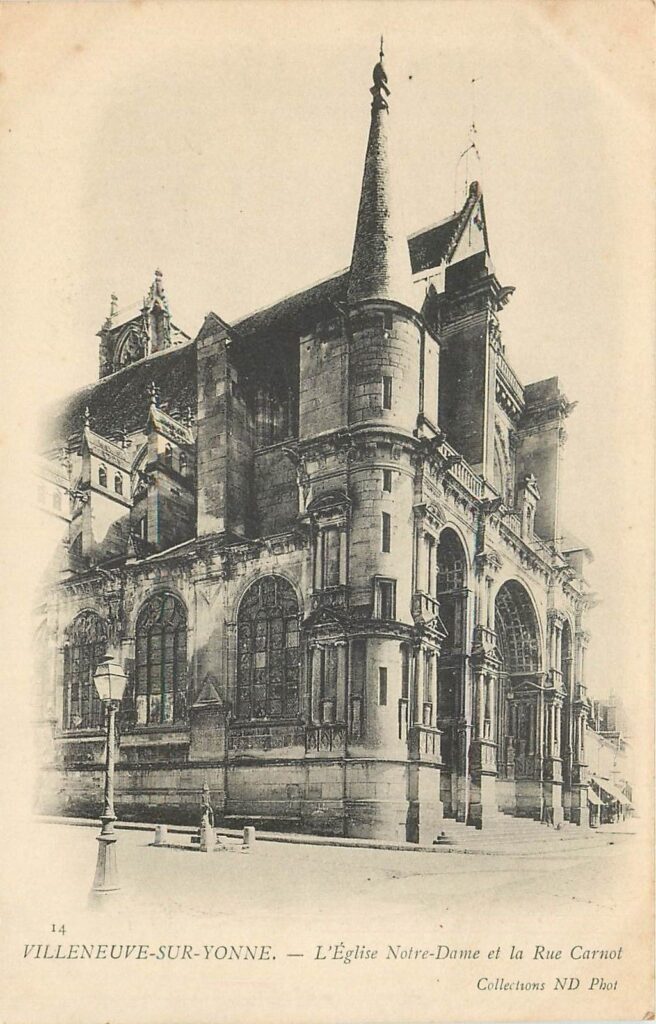
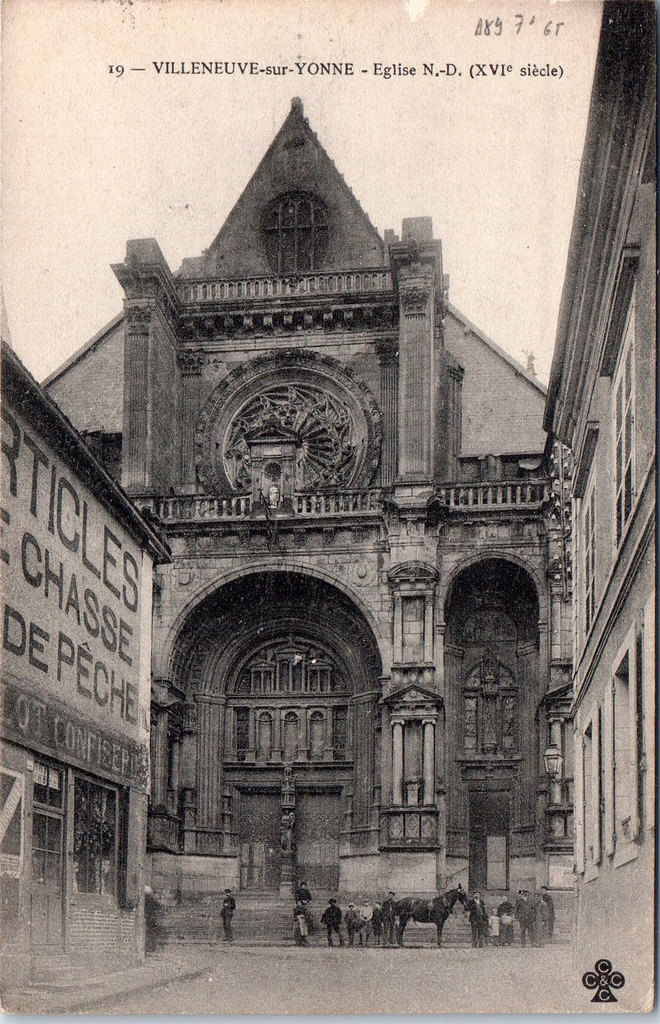
Began in the first quarter of the 13th century, construction of the church spread out into the 16th century. The highest point in the city, it is nearly as big as a cathedral!
The one clearly non-13th century aspect is its striking Renaissance façade. Its lower parts are inspired by the ancient model of a triumphal arch with its three semicircular portals (1547-1551) whereas the upper part is a composition from 1575. Designed by the architect Jean Chéreau, construction of the façade halted in 1594 due to the capture and burning of the city. In his plans for the façade, on display at the Porte de Joigny Historical Museum, he depicts two monumental towers which would have reached a height of 40 meters; these remain unfinished.
The church is open every afternoon from June to September. Outside this period, contact the Tourist Information Office.
La Tour Philippe Auguste
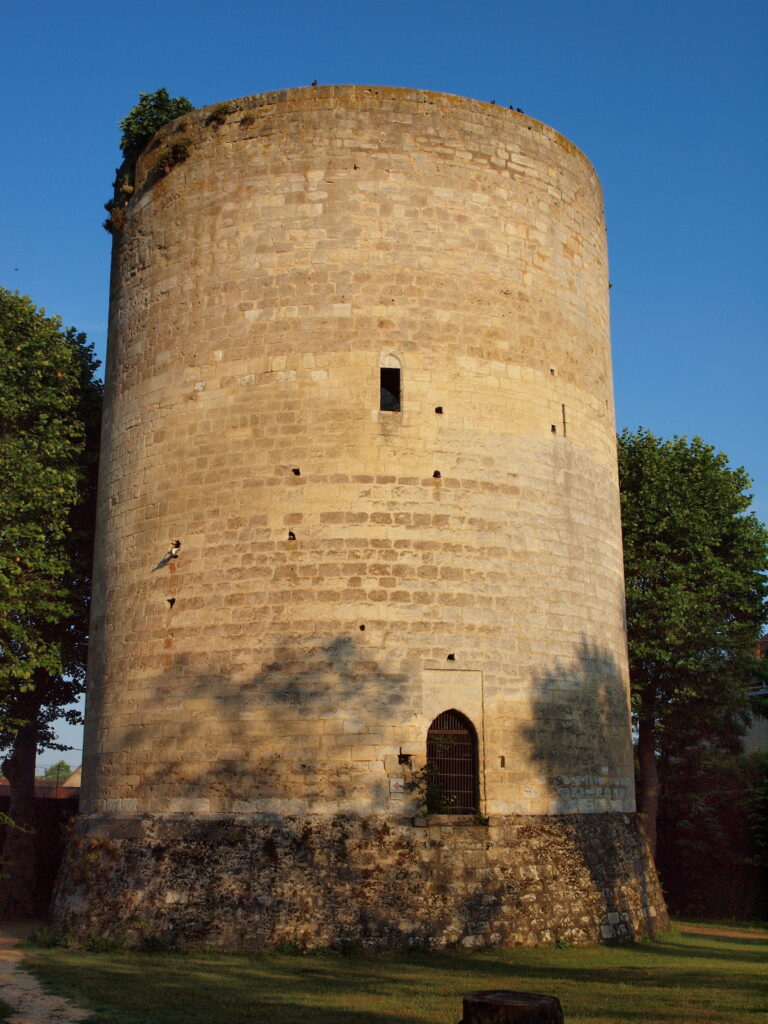
The Tour Philippe Auguste is a keep commanded by King Philippe Auguste in 1205. Completed in 1212, this fortified tower is a sign of royal power over Villeneuve-le-Roy. Separate from the ramparts, the keep was a nearly impenetrable refuge should the rest of the city fall to an adversary.
Abandoned from the 17th century, tales of disturbing creatures inhabiting its hallowed walls circulated amongst the city folk. Some believe that these stories inspired Chateaubriand who allegedly liked to come and sit on the stone bench which faces the tower.
Why Should You Visit?
Perhaps we were lucky when we went, because it seemed as though we were the only ones there. It was quiet, sunny and a lovely day for exploration. If you love to discover little villages and places off the normal tourist routes, this is definitely a place to try! It was a lovely time walking along the water and discovering all of the historical monuments throughout the city.
I had no idea that this little place would be so important. I wish we had gone when things were open to get the full experience of it all!
How English Friendly is It?
In terms of English-friendliness, it is a bit difficult to say when the museums were not open. However, based on the websites and city guides, it is not 100% suited towards those without some French skills. Unfortunately, the map that we used to discover the city is only available in French.
However, I have given a pretty good synopsis of the history and information contained in such guides here. With that in mind, you can go without a whole bunch of French skills and still enjoy the ambiance and the architecture.

Tips and Other Information
There are some nighttime events that occur at Villeneuve such as an arts and crafts market on some Saturday evenings as well as a sound and light show (from July to August), both taking place in the courtyard of the town hall next to the Porte de Sens.
Other attractions include the Musee-Galerie Carnot and its collection of historical depictions of Villeneuve as well as a scenic boat ride along the Yonne river in the Flipper Nautic.
Sens
Being that we were in the area, and because I am a giant nerd (as previously mentioned), we simply had to visit the Cathedral of Sens, and consequently its surroundings.
Sens, formally known as Agedincum, dates back to the Gallo-Roman period which is visible in the remains of its city walls. Hastily built around 275 -76 C.E. as protection against Germanic invaders, the walls composed about 30 towers and were created with Gallo-Roman funerary steles and other building components. The wall was torn down in the 17th century, but an existing remnant of the wall is the postern gate in the south.
During the Middle Ages, Sens was an extremely powerful archdiocese. The archbishop held the title of “Primate of the Gauls and Germania,” a position second to the Pope. Therefore, his influential position extended over the diocese of Chartres, Auxerre, Meaux, Paris, Orléans, Nevers and Troyes.
The Cathedral of Saint-Etienne

Dating to around 1130, the Cathedral of Sens is the first of the great Gothic cathedrals. An inspiration for Chartres, Bourges, Amiens and Canterbury, it is remarkable for its revolutionary use of the ribbed vault. The first (and only) Gothic cathedral in France and the world at this period, Pope Alexander III consecrated it in 1164, just as construction of Notre-Dame de Paris began.
Along with its architecture, the cathedral is host to a multitude of stained-glass windows depicting the evolution of the art from the 12th to the 19th centuries. One of the most notable is a full window illustrating the end of the life of Thomas Becket, illustrating his departure from Sens until his assassination in Canterbury.
Visits
You can get a guided tour of the cathedral and south tower (in June, July and August) by reservation at the Tourist Office, or you can simply take an audio guided tour.
On Saturdays, an hour-long guided tour called “Préludes aux Lumières de Sens” begins in front of the cathedral at 8:30pm (the cost seems to be about 6€, Please check with the Tourist Office). This is a prelude to the sound and light show that begins at 10:30PM.
If you can’t visit the cathedral IRL, they have created a lovely virtual tour accessible via this link.
The Sens Museums
To the right of the cathedral are the Sens Museums. Located in the former Archbishops Palace, the Sens museums regroup three different collections in one historical landmark. The palace is composed of: the Synodal palace dating to the 13th century, a Renaissance wing (1521), the stables (18th century) and a wing commissioned by Henri II (1550s).
The most remarkable of the collections is probably that of the Gallo-Roman period. Here you find the funerary steles once used to create the defensive walls, along with mosaics, sculptures, architectural elements and a reconstruction of the façade of a thermal building.
Entry is 7€ for adults and 5€ for 65+ and students; children under 17 are free. For more info including opening times and days, visit their website.
Marché Couvert (The Covered Market)
A typical example of 19th century metal architecture, the covered market whose form is triangular, is one of the rare models of its type in France. Began in 1879 and inaugurated in 1882, this market was recently restored and revamped in 2015.
I particularly love the inclusions of modern stained glass executed by Vitrail Saint-Georges located over each entryway. These were inspired by encyclopedic plates found in the 1862 Larousse Universal Dictionary.



Church of Saint-Maurice

This church really caught my attention! Floating above the water, this picturesque middle-12th-century church is a staple located on the îlle d’Yonne (the Yonne island).
Created for fishermen and bargemen, the church entered the register of Monuments Historiques in 1915. Unfortunately, this church is not open often, but you can access a visitor’s leaflet (in French) via this link.
Le Parc du Moulin à Tan (Park)
Taking its name from the windmill (moulin) used to extract tannin (tan) from tree bark built there in 1887, this park is a gem.
Several greenhouses embellish this park, with one housing a tropical rainforest biome. Here the main attraction is the “Victoria Cruziana.” Originating from the Amazon, the Victoria Cruziana it is a giant water lily. The park offers free guided tours of the greenhouses on Wednesdays in July and August (presumably in French).
For children, the park offers a mini farm, play areas and eight different permanent orientation courses.
The park is FREE and is open all year, with the greenhouses open every afternoon. Please note: it is a 30-ish minute walk from the center; there is free parking across from the entrance. For more information, visit their website.
Why Should You Visit?
We took on the Bornes du Patrimoine (heritage markers), a free activity to get you out and about. Whether you visit just the cathedral and the city (like we did) or take on the whole lot of activities Sens offers, you can easily spend a few days here!

Timber-framed houses, a giant water lily and the first Gothic cathedral are some of the remarkable pieces of history to experience.
I hope you will take the time to explore these two lovely places. If you do, let me know in the comments below! If you loved Villeneuve, be sure to check out Noyers-sur-Serein!
Bisous,
Rose
Read More:

